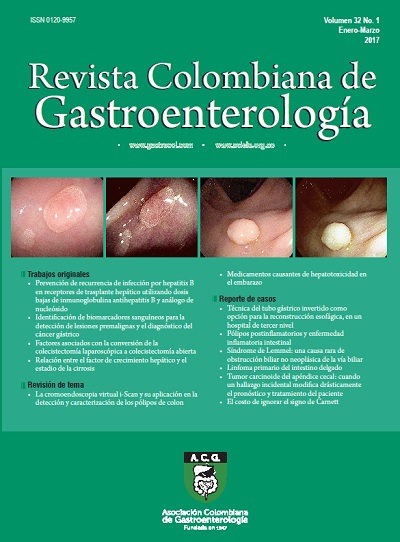Relación entre el factor de crecimiento hepático y el estadio de la cirrosis
DOI:
https://doi.org/10.22516/25007440.126Palavras-chave:
Cirrosis hepática, factor de crecimiento hepático, elastografía transitoria, Child-Pugh-TurcotteResumo
Introducción: en el hígado, el factor de crecimiento hepático (FCH) es conocido por ser un potente agente mitogénico tanto in vivo como in vitro. Sin embargo, el papel del FCH en la cirrosis no está completamente
claro y algunos estudios lo señalan como un marcador de severidad en la cirrosis, en la insuficiencia hepática aguda y en la hepatitis crónica.
Objetivos: determinar la relación entre el FCH y el estadio de la cirrosis
hepática e identificar los factores asociados con los niveles de FCH en esta población.
Metodología: se evaluaron todos los pacientes con cirrosis hepática atendidos desde enero a marzo de 2014. La elastografía transitoria (ET), la recopilación de la información clínica y la extracción de la muestra para la determinación del FCH se realizó de forma simultánea en el momento de la inclusión.
Resultados: no se encontró relación entre los niveles de FCH y la clasificación de Child-Pugh; sin embargo, se observaron niveles más elevados en pacientes con enfermedad descompensada. Se determinó una asociación lineal positiva entre el FCH y la dureza hepática estimada por elastografía (b = 0,53; r2 = 0,26; p = 0,002) y una asociación lineal negativa con la albúmina (b = -0,62; r2 = 0,39; p <0,001). Únicamente la albúmina conservó esta asociación en el análisis multivariante.
Conclusión: el FCH es un marcador de severidad en la cirrosis hepática. La albúmina y el grado de fibrosis determinada por ET se asociaron con niveles de FCH.
Downloads
Referências
Nagula S, Jain D, Groszmann RJ, et al. Histological-hemodynamic correlation in cirrhosis-a histological classification of the severity of cirrhosis. J Hepatol. 2006;44:111-7. doi: https://doi.org/10.1016/j.jhep.2005.07.036
Sethasine S, Jain D, Groszmann RJ, et al. Quantitative histological-hemodynamic correlations in cirrhosis. Hepatology. 2012;55:1146-53. doi: https://doi.org/10.1002/hep.24805
Ripoll C, Groszmann R, Garcia-Tsao G, et al. Hepatic venous pressure gradient predicts clinical decompensation in patients with compensated cirrhosis. Gastroenterology. 2007;133:481-8. doi: https://doi.org/10.1053/j.gastro.2007.05.024
Nakamura T, Nawa K, Ichihara A. Partial purification and characterization of hepatocyte growth factor from serum of hepatectomized rats. Biochem Biophys Res Commun. 1984;122:1450-9. doi: https://doi.org/10.1016/0006-291X(84)91253-1
Russell WE, McGowan JA, Bucher NL. Partial characterization of a hepatocyte growth factor from rat platelets. J Cell Physiol. 1984;119:183-92. doi: https://doi.org/10.1002/jcp.1041190208 - https://doi.org/10.1002/jcp.1041190207
Fabregat I, de Juan C, Nakamura T, et al. Growth stimulation of rat fetal hepatocytes in response to hepatocyte growth factor: modulation of c-myc and c-fos expression. Biochem Biophys Res Commun. 1992;189:684-90. doi: https://doi.org/10.1016/0006-291X(92)92255-V
Michalopoulos GK, DeFrances MC. Liver regeneration. Science. 1997;276:60-6. doi: https://doi.org/10.1126/science.276.5309.60
Fausto N. Liver regeneration. J Hepatol. 2000;32:19-31. doi: https://doi.org/10.1016/S0168-8278(00)80412-2
Huh CG, Factor VM, Sanchez A, et al. Hepatocyte growth factor/c-met signaling pathway is required for efficient liver regeneration and repair. Proc Natl Acad Sci. 2004;101:4477-82. doi: https://doi.org/10.1073/pnas.0306068101
Borowiak M, Garratt AN, Wustefeld T, et al. Met provides essential signals for liver regeneration. Proc Natl Acad Sci. 2004;101:10608-13. doi: https://doi.org/10.1073/pnas.0403412101
Phaneuf D, Moscioni AD, LeClair C, et al. Generation of a mouse expressing a conditional knockout of the hepatocyte growth factor gene: demonstration of impaired liver regeneration. DNA Cell Biol. 2004;23:592-603. doi: https://doi.org/10.1089/dna.2004.23.592
Suarez-Causado A, Caballero-Diaz D, Bertran E, et al. HGF/c-Met signaling promotes liver progenitor cell migration and invasion by an epithelial-mesenchymal transition-independent, phosphatidyl inositol-3 kinase-dependent pathway in an in vitro model. Biochim Biophys Acta. 2015;1853:2453-63. doi: https://doi.org/10.1016/j.bbamcr.2015.05.017
Fujimoto J, Kaneda Y. Reversing liver cirrhosis: impact of gene therapy for liver cirrhosis. Gene Ther. 1999;6:305-6. doi: https://doi.org/10.1038/sj.gt.3300885
Shiota G, Okano J, Kawasaki H, et al. Serum hepatocyte growth factor levels in liver diseases: clinical implications. Hepatology. 1995;21:106-12. doi: https://doi.org/10.1002/hep.1840210119
Prystupa A, Kicinski P, Sak J, et al. Proinflammatory cytokines (IL-1alpha, IL-6) and hepatocyte growth factor in patients with alcoholic liver cirrhosis. Gastroenterol Res Pract. 2015;2015:532615. doi: https://doi.org/10.1155/2015/532615
Pavlov CS, Casazza G, Nikolova D, et al. Transient elastography for diagnosis of stages of hepatic fibrosis and cirrhosis in people with alcoholic liver disease. Cochrane Database Syst Rev. 2015;1:CD010542. doi: https://doi.org/10.1002/14651858.cd010542.pub2
Sandrin L, Fourquet B, Hasquenoph JM, et al. Transient elastography: a new noninvasive method for assessment of hepatic fibrosis. Ultrasound Med Biol. 2003;29:1705-13. doi: https://doi.org/10.1016/j.ultrasmedbio.2003.07.001
Ciccarelli N, Fabbiani M, Grima P, et al. Liver fibrosis is associated with cognitive impairment in HIV-positive patients. J Int AIDS Soc. 2014;17:19722. doi: https://doi.org/10.7448/IAS.17.4.19722
Kitson MT, Roberts SK, Colman JC, et al. Liver stiffness and the prediction of clinically significant portal hypertension and portal hypertensive complications. Scand J Gastroenterol. 2015;50:462-9. doi: https://doi.org/10.3109/00365521.2014.964758
Pang JX, Zimmer S, Niu S, et al. Liver stiffness by transient elastography predicts liver-related complications and mortality in patients with chronic liver disease. PLoS One. 2014;9:e95776. doi: https://doi.org/10.1371/journal.pone.0095776
Singh S, Fujii LL, Murad MH, et al. Liver stiffness is associated with risk of decompensation, liver cancer, and death in patients with chronic liver diseases: a systematic review and meta-analysis. Clin Gastroenterol Hepatol. 2013;11:1573-84. doi: https://doi.org/10.1016/j.cgh.2012.12.036
https://doi.org/10.1016/j.cgh.2013.07.034
Tajima H, Nakamura T. [Function, molecular structure and gene expression regulation of hepatocyte growth factor and its receptor]. Nihon Rinsho. 1992;50:1918-25.
Kinoshita T, Tashiro K, Nakamura T. Marked increase of HGF mRNA in non-parenchymal liver cells of rats treated with hepatotoxins. Biochem Biophys Res Commun. 1989;165:1229-34. doi: https://doi.org/10.1016/0006-291X(89)92733-2
Hamanoue M, Kawaida K, Takao S, et al. Rapid and marked induction of hepatocyte growth factor during liver regeneration after ischemic or crush injury. Hepatology. 1992;16:1485-92. doi: https://doi.org/10.1002/hep.1840160626
Porowski D, Wirkowska A, Hryniewiecka E, et al. Liver failure impairs the intrahepatic elimination of interleukin-6, tumor necrosis factor-alpha, hepatocyte growth factor, and transforming growth factor-beta. Biomed Res Int. 2015;2015:934065. doi: https://doi.org/10.1155/2015/934065
Vessey CJ, de la Hall PM. Hepatic stem cells: a review. Pathology. 2001;33:130-41. doi: https://doi.org/10.1080/00313020120038719
https://doi.org/10.1080/00313020124028
Jiang JX, Venugopal S, Serizawa N, et al. Reduced nicotinamide adenine dinucleotide phosphate oxidase 2 plays a key role in stellate cell activation and liver fibrogenesis in vivo. Gastroenterology. 2010;139:1375-84. doi: https://doi.org/10.1053/j.gastro.2010.05.074
Uchida K, Inoue M, Otake K, et al. The significance of serum hepatocyte growth factor levels in planning follow-up of postoperative jaundice-free patients with biliary atresia. J Pediatr Surg. 2006;41:1657-62. doi: https://doi.org/10.1016/j.jpedsurg.2006.05.058
Shiota G, Rhoads DB, Wang TC, et al. Hepatocyte growth factor inhibits growth of hepatocellular carcinoma cells. Proc Natl Acad Sci. 1992;89:373-7. doi: https://doi.org/10.1073/pnas.89.1.373
Garcia-Tsao G, Friedman S, Iredale J, et al. Now there are many (stages) where before there was one: In search of a pathophysiological classification of cirrhosis. Hepatology. 2010;51:1445-9. doi: https://doi.org/10.1002/hep.23478
D'Amico G, Garcia-Tsao G, Pagliaro L. Natural history and prognostic indicators of survival in cirrhosis: a systematic review of 118 studies. J Hepatol. 2006;44:217-31. doi: https://doi.org/10.1016/j.jhep.2005.10.013
Downloads
Publicado
Como Citar
Edição
Seção
Licença
Aquellos autores/as que tengan publicaciones con esta revista, aceptan los términos siguientes:
Los autores/as ceden sus derechos de autor y garantizarán a la revista el derecho de primera publicación de su obra, el cuál estará simultáneamente sujeto a la Licencia de reconocimiento de Creative Commons que permite a terceros compartir la obra siempre que se indique su autor y su primera publicación en esta revista.
Los contenidos están protegidos bajo una licencia de Creative Commons Reconocimiento-NoComercial-SinObraDerivada 4.0 Internacional.




















